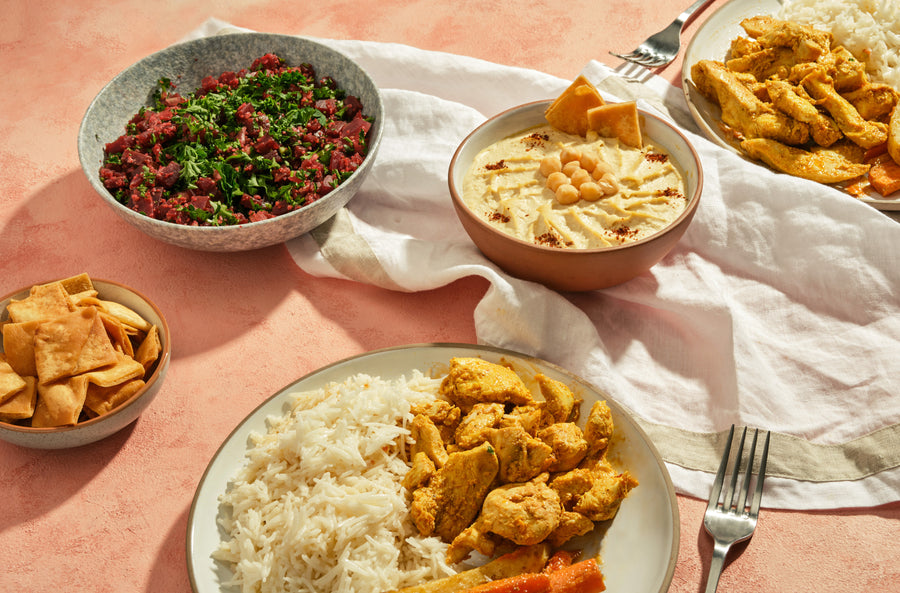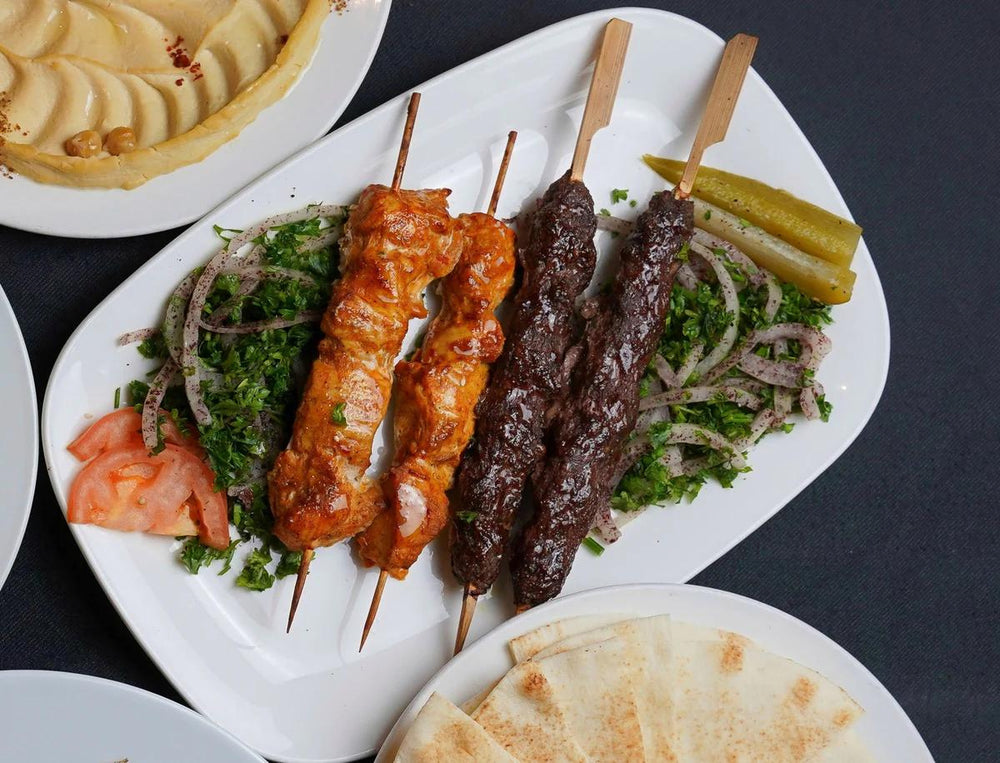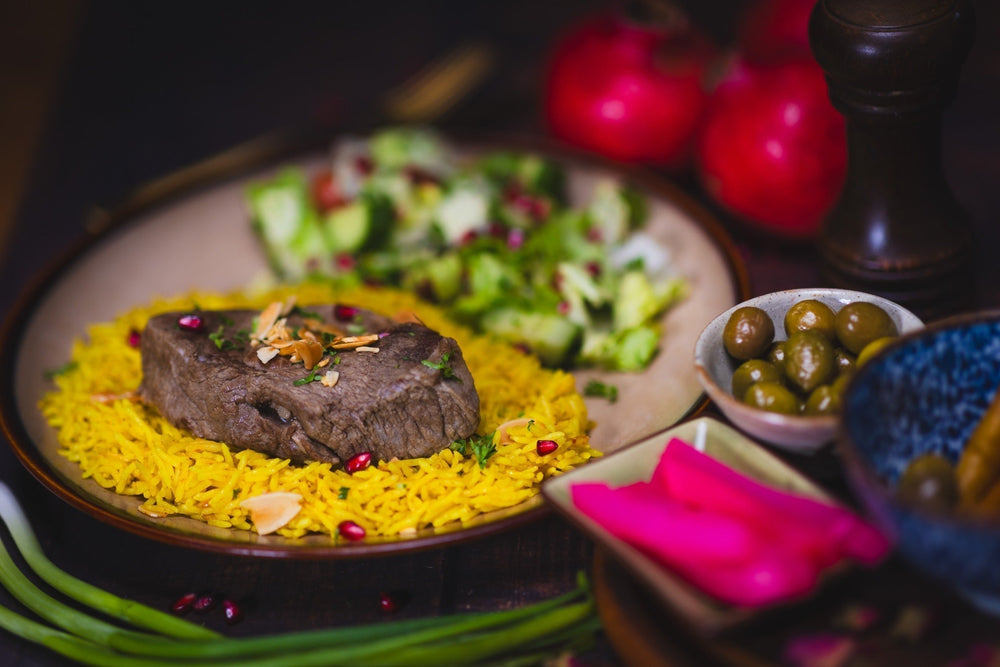A Deep Dive Into Syrian Cuisine: Recognizing Its Cultural Importance and Halal Aspects
Syrian cuisine embodies a rich tapestry of historical narratives and social influences. Each meal informs a tale of community and practice, emphasizing the value of common dishes. The adherence to halal practices not only shows faiths however likewise forms the identity of Syrian food preparation. As worldwide occasions challenge these cooking practices, the resilience of this food stays a focal factor of social conservation. What lies behind the tastes that define this sustaining heritage?
The Historical Roots of Syrian Food
Syrian food has actually evolved over centuries, its historic roots are deeply linked with the region's varied social impacts. Positioned at the crossroads of different civilizations, Syria has absorbed culinary methods from the Phoenicians, Greeks, Romans, and Ottomans, to name a few. This rich tapestry of history has contributed to a food characterized by a mix of flavors, spices, and food preparation methods. The abundant lands of the area have actually also played a vital role, giving a wealth of grains, fruits, and vegetables that form the structure of lots of dishes. The introduction of brand-new active ingredients with trade and occupation further enriched the cooking landscape, allowing for the growth of distinct regional specializeds. Additionally, the impact of bordering countries has led to a vibrant exchange of cooking ideas, strengthening Syria's position as a considerable gamer in the more comprehensive context of Center Eastern gastronomy.

Conventional Syrian Dishes and Their Cultural Relevance
Traditional Syrian meals are not just culinary staples however additionally lug deep social importance, reflecting the nation's rich heritage. Famous dishes, frequently prepared throughout cheery events, act as a method of uniting families and neighborhoods. These meals embody the tastes of Syria while enhancing social bonds with shared traditions and celebrations.
Iconic Syrian Staples
When exploring the rich tapestry of Syrian food, one uncovers a selection of iconic dishes that not just entice the taste buds but also embody the nation's social heritage. Among these staples, Kabsa stands apart as a great smelling rice recipe, commonly skilled with seasonings like saffron and cardamom, symbolizing friendliness. Fattoush, a vibrant salad made with blended greens and crispy bread, mirrors the relevance of fresh ingredients in Syrian food preparation. Muhammara, a spicy dip made from peppers and walnuts, showcases the rich flavors particular of the area. Furthermore, Kibbeh, a dish made from bulgur and minced meat, is often concerned as a nationwide prize, standing for public gatherings. Each recipe informs a story, linking individuals to their roots and traditions.
Cheery Dish Practices
Syrian festive dish practices are abundant with symbolism and relevance, as family members gather to commemorate important events with the sharing of cherished meals. Dishes often display a range of conventional foods, with recipes like mansaf, kibbeh, and tabbouleh taking center phase. Each recipe brings cultural background; for circumstances, kibbeh, made from bulgur and minced meat, stands for friendliness and abundance. During Ramadan and Eid, families prepare unique sugary foods such as maamoul, signifying pleasure and unity. These events foster community bonds, as sharing a meal represents love and togetherness. The preparation and satisfaction of these meals mirror Syria's varied culinary heritage, linking household custom-mades and local influences, thereby enhancing the joyful experience and maintaining social identification.
The Function of Family and Community in Syrian Food Society
Food offers as a necessary string that weaves with each other household and area in Syrian culture. Dishes are typically communal experiences, where households collect around a table to share standard meals that reflect their heritage. The prep work of food is a communal activity, with generations functioning side by side, passing down dishes and food preparation methods. This method enhances familial bonds and promotes a sense of belonging within the community.Special events and spiritual events additionally highlight the value of food in Syrian culture. Throughout these events, families prepare fancy meals that serve not only to nourish but likewise to share love and hospitality. The act of sharing food signifies unity and assistance among next-door neighbors and buddies, strengthening social connections. Via these shared culinary experiences, Syrians cultivate a solid identification rooted in their abundant social background, showing exactly how food transcends mere food to become a critical part of their social textile.
Halal Practices in Syrian Food Preparation
In the context of communal dishes and household celebrations, halal techniques play a substantial function in Syrian food preparation. These methods stem from Islamic dietary regulations, making sure that food is prepared and eaten in a manner that lines up with religious ideas. For several Syrian households, adherence to halal concepts affects different aspects of dish preparation, from sourcing components to cooking methods.Animals utilized for meat should be slaughtered according to details guidelines, stressing humane therapy and conjuring up the name of Allah. Additionally, cross-contamination with non-halal things is carefully stayed clear of in both home cooking areas and business establishments.This dedication to halal not only shows spiritual devotion but additionally cultivates a sense of neighborhood, as households usually collaborated to share meals that recognize these customs - Brunch Kitsilano Vancouver BC. As a result, halal practices are deeply woven right into the textile of Syrian cooking culture, forming both daily life and joyful celebrations
Ingredients That Define Syrian Flavors

The essence of Syrian cuisine is shaped by a harmonious blend of essential spices and herbs that enhance its distinctive flavors. Conventional food preparation strategies further elevate these ingredients, showcasing the rich culinary heritage of the region. An overview of crucial active ingredients discloses the fundamental duty they play in producing authentic Syrian dishes.
Key Seasonings and Natural Herbs
A lively tapestry of tastes identifies Syrian cuisine, with vital seasonings and natural herbs playing a crucial role in specifying its significance. Popular amongst these are cumin, coriander, and sumac, which provide depth and warmth to numerous recipes. Cumin, with its nutty fragrance, frequently enhances stews and grilled meats, while coriander adds a citrusy note to salads and dips. Sumac, recognized for its appetizing taste, brightens dishes Check Out Your URL and is regularly sprayed over fattoush or kebabs. In addition, cinnamon and allspice give a subtle sweet taste, frequently found in both full-flavored and sweet preparations. Fresh natural herbs like parsley, dill, and mint are likewise crucial, providing a ruptured of quality and stabilizing the rich, complicated flavors that make Syrian food distinct.
Traditional Food Preparation Techniques
Food preparation techniques in Syrian food show an ingrained custom that boosts the flavors of its active ingredients. Methods such as slow-cooking and braising are frequently utilized, enabling natural herbs and flavors to fuse magnificently with meats and vegetables. Cooking, particularly over charcoal, imparts a great smoky splendor to dishes like kebabs, while steaming is usually made use of for rice, preserving its structure and taste. Furthermore, sautéing is preferred for preparing aromatic bases, typically beginning with onions and garlic to develop depth. Fermentation plays a role in developing special flavors, apparent in recipes like pickled veggies. These methods not just highlight the high quality of ingredients but also symbolize the public spirit of cooking, bringing family members with each other around shared dishes soaked in practice.
Vital Active Ingredients Summary
While exploring Syrian cuisine, one quickly uncovers that crucial active ingredients play a pivotal function in specifying its special tastes. Olive oil, a staple, offers splendor and deepness, often serving pop over to these guys as a base for lots of dishes. Fresh natural herbs, such as mint, parsley, and cilantro, add dynamic fragrances and preferences, improving the overall experience (Brunch Kitsilano Vancouver BC). Spices like cumin, coriander, and cinnamon are often utilized, including warmth and complexity to dishes. Furthermore, Syrian cuisine heavily integrates grains, specifically bulgur and right here rice, which act as essential components in different dishes. Pulses, especially chickpeas and lentils, use both nourishment and appearance. With each other, these components produce the unified balance that characterizes Syrian recipes, mirroring the nation's rich culinary heritage and social relevance
The Impact of Battle on Syrian Cooking Traditions
The battle in Syria has functioned destruction across the nation, its effect on cooking practices exposes a complicated interplay of resilience and adjustment. As areas encountered displacement, typical dishes were customized because of the scarcity of ingredients and sources. Family members commonly count on locally readily available produce, integrating brand-new tastes and techniques right into their dishes, which brought about the introduction of unique interpretations of timeless dishes.Moreover, the battle cultivated a spirit of solidarity amongst displaced cooks and home cooks, who shared their culinary understanding via social networks and area kitchen areas. This sharing of dishes not only maintained cultural heritage but additionally developed a feeling of belonging amongst those impacted by the problem. Despite the challenges, the interest for food stays a unifying pressure, permitting people to keep their identification and get in touch with their origins, even in expatriation. Syrian food continues to evolve amid misfortune, showing both an abundant history and modern durability.
Often Asked Concerns
What Are Typical Food Preparation Techniques Made Use Of in Syrian Food?
Typical cooking techniques in Syrian cuisine include cooking, cooking, sautéing, and cooking. These methods enhance tastes and structures, permitting the development of diverse dishes that show the region's abundant culinary heritage and customs.
Exactly How Has Globalization Influenced Syrian Food?

Exist Vegetarian Options in Typical Syrian Recipes?
Vegetarian alternatives are widespread in standard Syrian dishes, featuring active ingredients like lentils, chickpeas, and veggies. Popular meals such as Mujadara and Falafel highlight this variety, fitting numerous dietary choices while protecting the rich tastes of the cuisine.
What Beverages Pair Well With Syrian Dishes?
Beverages that match well with Syrian dishes include mint tea, pomegranate juice, and ayran - Brunch Kitsilano Vancouver BC. These beverages match the tastes of conventional dishes, boosting the dining experience while giving stimulating contrasts to the abundant, full-flavored tastes
Just How Do Syrians Commemorate Food Throughout Holidays or Festivals?
Syrians celebrate food throughout vacations and events with sophisticated feasts, usually featuring conventional dishes. Family events highlight sharing meals, symbolizing unity and cultural heritage, while special treats and sugary foods highlight the joyful spirit and communal delight. Standard Syrian recipes are not just cooking staples however also lug deep social importance, showing the nation's abundant heritage. When discovering the abundant tapestry of Syrian food, one finds a range of famous meals that not just entice the taste yet additionally embody the country's social heritage. Syrian festive dish practices are rich with significance and value, as family members gather to celebrate important events through the sharing of beloved meals. Food preparation techniques in Syrian cuisine mirror a deep-rooted tradition that boosts the tastes of its ingredients. Vegan options are prevalent in typical Syrian dishes, featuring ingredients like lentils, vegetables, and chickpeas.